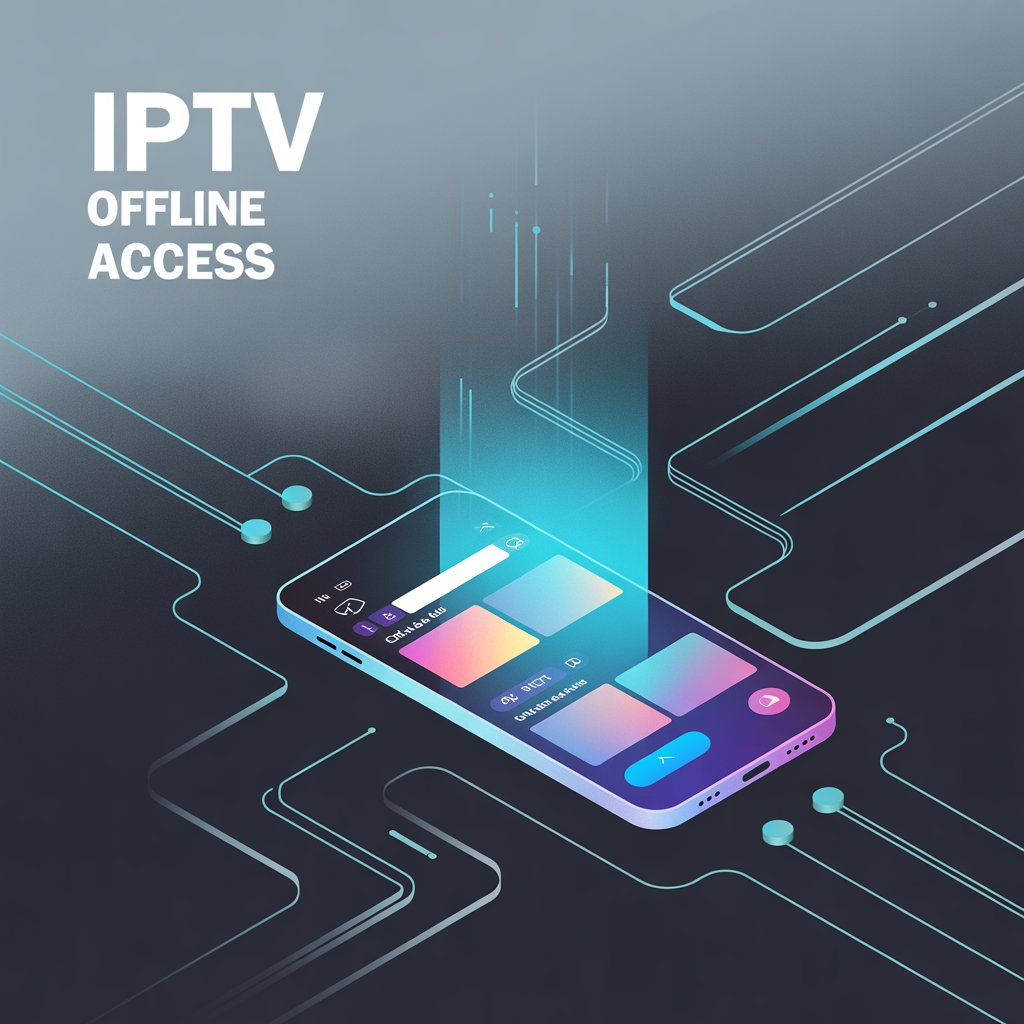
Never Miss a Moment: 7 Essential IPTV Offline Access Features for Seamless Viewing in 2025
In 2025, our lives are more connected than ever, yet moments of disconnection are inevitable. Whether you’re on a long flight, commuting through a subway tunnel, or simply experiencing a temporary internet outage at home, losing access to your favorite shows and movies can be frustrating. This is where the power of IPTV offline access features truly shines. Internet Protocol Television (IPTV) has already transformed how we consume media, offering unparalleled flexibility and a vast array of content directly over the internet. Now, with robust offline capabilities, it’s taking convenience to an entirely new level for users across the United States.
Imagine being able to download your entire binge-watching list before a road trip, or catching up on the news during your daily commute without burning through mobile data. These scenarios are becoming the norm, thanks to advanced IPTV offline access features. This functionality isn’t just about entertainment; it’s about empowering viewers with control over their content, ensuring reliability, and optimizing data usage in an increasingly mobile world.
This comprehensive guide will delve deep into the world of IPTV offline access features. We’ll explore the essential functionalities to look for, the significant benefits they offer to various user segments in the US, the technical aspects that make them possible, and the challenges providers face in implementing them. Get ready to discover how offline viewing is revolutionizing your IPTV experience, ensuring you never miss a moment of your preferred content, no matter where you are or what your internet connection looks like.
Table of Contents
- What is IPTV Offline Access?
- Why Offline Access Matters in 2025 for US Viewers
- 7 Essential IPTV Offline Access Features to Look For
- Benefits for Different User Segments in the USA
- How IPTV Providers Implement Offline Access
- Challenges and Key Considerations for Offline IPTV
- Choosing an IPTV Provider with Robust Offline Features
- The Future of IPTV Offline Access
- Conclusion: Your Content, Your Terms
What is IPTV Offline Access?
At its core, IPTV (Internet Protocol Television) delivers content over the internet, offering live TV, Video-on-Demand (VOD), and interactive services. Traditionally, this requires a continuous internet connection. However, IPTV offline access features refer to the capability within an IPTV service or application that allows users to download selected content (movies, TV shows, documentaries, etc.) to their device for viewing without an active internet connection. Think of it like downloading a playlist on a music streaming service, but for video content.
This functionality transforms IPTV from a purely online streaming service into a hybrid model, offering flexibility that caters to modern viewing habits and connectivity challenges. It’s a crucial evolution that enhances the user experience significantly. For a deeper understanding of IPTV, you can refer to our What is IPTV? guide.
Why Offline Access Matters in 2025 for US Viewers
For viewers in the United States, the importance of robust IPTV offline access features cannot be overstated. Our lives are increasingly mobile, and internet connectivity isn’t always guaranteed or affordable.
1. Uninterrupted Entertainment on the Go
Whether you’re traveling across the country, flying internationally, or simply commuting on public transport with spotty Wi-Fi, offline access ensures your entertainment never stops. Long flights or train rides become opportunities to catch up on your favorite series without relying on expensive in-flight Wi-Fi or unreliable public networks. This is a primary driver for seeking out strong IPTV offline access features.
2. Saving Mobile Data
Streaming high-definition video consumes significant mobile data. By downloading content over Wi-Fi at home or a public hotspot, users can dramatically reduce their cellular data consumption, avoiding costly overage charges or hitting data caps. This makes IPTV offline access features a smart financial choice for many. Learn more about cutting streaming costs and managing data usage.
3. Reliability During Internet Outages
Home internet can be unpredictable. Power outages, network issues, or even maintenance work can leave you without a connection. Having downloaded content means you still have access to entertainment, ensuring that a temporary loss of internet doesn’t mean a loss of leisure. This reliability factor is a key benefit of IPTV offline access features.
4. Access in Remote Areas
For those living in or traveling to rural areas of the USA where high-speed internet is scarce or non-existent, offline access becomes essential. It allows residents to download content when they do have a connection and enjoy it later, bridging the digital divide for entertainment. This is particularly relevant for the practical application of IPTV offline access features.
5. Enhanced Privacy and Security
Downloading content means you’re not constantly streaming over potentially insecure public Wi-Fi networks. This can offer an added layer of privacy and security, as your viewing is localized to your device. While not a primary security feature, it’s a fringe benefit of utilizing IPTV offline access features.
7 Essential IPTV Offline Access Features to Look For
Not all offline access is created equal. When evaluating IPTV providers, pay close attention to these 7 essential IPTV offline access features:
1. Comprehensive Download Capabilities
The ability to download a wide range of content is fundamental. This includes:
- Full Library Access: Can you download most, if not all, VOD content?
- Live TV Recording for Offline: Can you record live TV broadcasts and then download them for later offline viewing?
- Series Download: Option to download entire seasons or multiple episodes of a show at once.
2. Flexible Download Quality Options
Users should have control over download quality (e.g., Standard Definition, High Definition, 4K). This allows them to balance video quality with storage space and download time. For example, downloading SD for a long trip where storage is limited, or 4K for a short, high-quality viewing experience at home. This flexibility is a key aspect of advanced IPTV offline access features.
3. Clear Storage Management & Limits
The app should clearly show how much storage space downloaded content is consuming and allow easy management (e.g., deleting old downloads). Some providers might impose limits on the number of downloads or total storage, so understanding these is crucial. Efficient storage management is vital for practical IPTV offline access features.
4. Download Expiry and Renewal
Downloaded content often has an expiry period (e.g., 30 days from download, or 48 hours after first playback). The app should clearly communicate these expiry dates and ideally allow for easy renewal or re-downloading. Transparency about content expiry is important for user satisfaction with IPTV offline access features.
5. Robust Multi-Device Compatibility
Can you download content to various devices? This includes smartphones, tablets, and potentially laptops. Ensure the app is available and functions well across your preferred devices. This multi-device support enhances the utility of IPTV offline access features. See our guide on multi-device streaming setups.
6. Intuitive Offline Content Library & Playback
Once downloaded, finding and playing content should be seamless. The app needs a dedicated “Downloads” or “Offline” section that’s easy to navigate. Playback should be smooth, with all standard controls (pause, fast-forward, rewind) functioning perfectly without internet. A user-friendly interface is key to effective IPTV offline access features.
7. Background Downloading & Notification
The ability to initiate downloads and have them continue in the background while you use other apps or even lock your device is a huge convenience. Notifications upon completion are also helpful. This ensures a smooth user experience when utilizing IPTV offline access features.
Benefits for Different User Segments in the USA
The advantages of IPTV offline access features resonate across various demographics in the United States:
1. The Daily Commuter
For millions who rely on public transport, subway systems, or areas with poor cellular coverage, offline access transforms commute time into entertainment time. They can watch shows, news, or sports highlights without interruption or data drain.
2. The Frequent Traveler (Domestic & International)
Long flights, road trips, and hotel stays with unreliable Wi-Fi are prime scenarios for offline viewing. Travelers can pre-load content, ensuring they have entertainment regardless of connectivity. This is especially valuable for international travel where data roaming is expensive. This makes IPTV offline access features invaluable for globetrotters.
3. The Budget-Conscious Consumer
With rising data costs and tiered internet plans, downloading content over home Wi-Fi is a smart financial move. It helps users avoid exceeding data caps on their mobile plans, making their IPTV subscription even more cost-effective. This is a significant economic benefit of IPTV offline access features.
4. Residents in Rural or Underserved Areas
For communities with limited broadband infrastructure, offline access provides a workaround. Residents can utilize intermittent or lower-speed connections to download content, then enjoy it in high quality without buffering. This helps bridge the digital divide for content consumption.
5. Students and On-the-Go Professionals
Whether studying in a library with limited Wi-Fi or working remotely from various locations, having access to educational content, news, or even background entertainment offline can be a productivity booster and a stress reliever. The flexibility of IPTV offline access features supports diverse lifestyles.
How IPTV Providers Implement Offline Access
Implementing robust IPTV offline access features involves several technical steps for providers:
1. Content Licensing Agreements
The first hurdle is legal. Providers must secure specific licensing rights from content owners that permit downloading and offline playback. Not all content is available for offline viewing due to these agreements.
2. Digital Rights Management (DRM)
To prevent piracy, downloaded content is protected by DRM technologies. This encrypts the content and ensures it can only be played back within the authorized app and for the permitted duration. This is a critical security layer for IPTV offline access features.
3. Encoding and Compression
Content is typically encoded in various resolutions and compressed to optimize file size for downloads. This allows users to choose quality settings that fit their storage and bandwidth. Efficient compression is key for practical IPTV offline access features.
4. Client-Side Storage and Playback
The IPTV application on the user’s device manages the download, storage, and playback of the encrypted content. This requires robust app development to handle large files and ensure smooth performance without an internet connection.
5. Synchronization and Expiry Logic
The app needs a mechanism to periodically “check in” with the server (when online) to verify subscription status, update content libraries, and enforce download expiry rules. This ensures compliance with licensing terms.
6. Content Delivery Networks (CDNs)
Providers leverage CDNs to efficiently deliver download files to users, minimizing latency and improving download speeds. This is the same technology that ensures smooth online streaming. Read more about CDNs on Akamai’s website.
Challenges and Key Considerations for Offline IPTV
While highly beneficial, IPTV offline access features come with their own set of challenges for both providers and users:
1. Content Availability Restrictions
Challenge: Due to complex licensing agreements, not all content in an IPTV library may be available for offline download. This can be frustrating for users.
Solution: Providers should clearly indicate which content is downloadable. Users should manage expectations and prioritize downloading content known to be available offline.
2. Device Storage Limitations
Challenge: High-quality video files can consume significant storage space on mobile devices, which often have limited memory.
Solution: Offer multiple download quality options. Educate users on managing their device storage. Encourage external storage solutions where applicable. This is a practical consideration for maximizing IPTV offline access features.
3. Content Expiry and DRM
Challenge: Downloaded content typically expires after a set period or once playback begins, requiring re-downloading or re-authentication when online.
Solution: Clear communication of expiry rules. Seamless re-authentication processes. Users should be aware of these limitations before relying heavily on offline content.
4. Updates and Bug Fixes
Challenge: Offline content might not receive immediate updates or bug fixes if the user remains offline for extended periods.
Solution: Regular app updates that optimize offline functionality. Users should periodically connect to the internet to ensure their app is up-to-date.
5. Data Security for Downloaded Content
Challenge: While DRM protects content, the security of the device itself becomes paramount. If a device is lost or stolen, downloaded content could be accessed.
Solution: Encourage users to use strong device passwords and encryption. Providers should ensure robust DRM and app-level security. This is an important security aspect of IPTV offline access features.
Choosing an IPTV Provider with Robust Offline Features
If IPTV offline access features are a priority for you in the USA, here’s a checklist for selecting the right provider:
- Verify Offline Capabilities: Does the provider explicitly advertise offline downloads? Is it available on your preferred devices?
- Content Library for Offline: Inquire about the percentage or specific types of content available for download. Some services might only offer a limited selection.
- Download Quality Options: Check if they offer different quality settings to manage storage.
- Storage & Expiry Rules: Understand any limits on downloads, how long content lasts, and how to renew it.
- User Experience: Test the app (if a trial is available) for ease of use in managing and playing downloaded content.
- Reviews: Look for user reviews specifically mentioning the quality and reliability of their offline features.
- Overall Service Quality: Ensure the provider offers good streaming quality, reliable customer support, and a content library that meets your overall needs. Our guide on choosing the best IPTV providers can help with general service quality.
The Future of IPTV Offline Access
The evolution of IPTV offline access features is far from over. In the coming years, we can expect even more sophisticated developments:
- Smarter Content Caching: AI-driven systems that intelligently pre-download content they predict you’ll want to watch, based on your habits and upcoming travel plans, without you even initiating the download.
- Enhanced Storage Solutions: More seamless integration with cloud storage or external drives for managing larger offline libraries.
- Interactive Offline Content: Beyond passive viewing, future offline content might include interactive elements, quizzes, or even limited social features that sync when you reconnect.
- Blockchain-Enhanced DRM: Utilizing blockchain for more transparent and secure content licensing and rights management, potentially offering more flexible offline access terms. This ties into concepts in IPTV Crypto Rewards 2025.
- Universal Offline Standards: Greater industry standardization for offline playback, making the experience more consistent across different platforms and devices.
- Live Event Offline Capture: The ability to automatically capture and download live events (e.g., sports, concerts) for later viewing shortly after they conclude, even if you couldn’t watch them live.
These advancements will continue to make IPTV offline access features an indispensable part of the modern viewing experience, offering unprecedented freedom and control.
Conclusion: Your Content, Your Terms
In 2025, IPTV offline access features are no longer a luxury but a fundamental expectation for many viewers in the United States. They offer a powerful solution to the challenges of inconsistent internet connectivity, high mobile data costs, and the desire for uninterrupted entertainment on the go.
By understanding the key features and benefits, and by carefully choosing a provider that prioritizes robust offline capabilities, you can unlock a new level of freedom and convenience in your streaming habits. Embrace the power of downloaded content, and ensure your favorite shows, movies, and live events are always available, on your terms, whenever and wherever you choose to watch.
What’s Your Favorite Way to Use IPTV Offline Access?
Do you already use IPTV offline access features? What content do you prioritize for downloading, and how has it changed your viewing habits?
Share your experiences and tips in the comments below! Let’s help each other make the most of offline streaming.
SEO-friendly URL slug suggestion: /iptv-offline-access-features-guide

